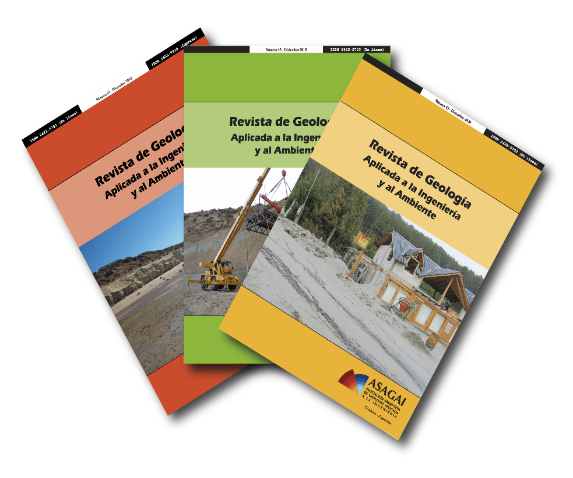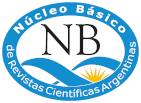Use of a rock fall risk measurement system in operational phase on the Altas Cumbres road, Sierra Chica, Córdoba, Argentina
Keywords:
rockfall, stability, rock mass, riskAbstract
This paper shows the conclusions of the second stage of a research project developed in the Faculty of Engineering of the Catholic University of Córdoba, whose objective is the application of geotechnical models for the analysis of risk of falling rocks in mountains routes.
The first part of the project was dedicated to the establishment of a "baseline" in the RP34 - Camino de Altas Cumbres – at Sierra Chica, Córdoba, through the modified Rockfall Risk Rating System. (RHRS – Rockfall Hazard Rating System) carried out at time zero, that is, a few months after release to traffic, and allowed for basic information on the situation of the slopes.
After more than a year the road has been in operation, rock falls have been recorded on various slopes that determined a new risk scheme and allowed the functioning of the implemented system to be observed.
The results obtained made it possible to detect those variables that underwent changes and affected the risk indices, and to separate them from others whose changes or increases remained below a threshold that did not cause changes in the risk category.
In this way, the variables considered by the system that must be monitored in detail on each slope were defined to determine actions to be implemented to avoid an increase in the category and, consequently, the risk value.
References
AASHTO. 2011. A Policy on Geometric Design of Highways and Streets. Tomo 1. Anexo 3. Distancia Visual de Detención.
Ansari M., Ahmad M., Singh R., y Singh T. (2016). Rockfall Hazard Rating System along SH-72: a case study of Poladpur–Mahabaleshwar road (Western India), Maharashtra, India, Geomatics, Natural Hazards and Risk, 7:2, 649-666, DOI: 10.1080/19475705.2014.1003416
Bouali E.H., Vitton S., Brooks C., Rockfall Hazard Rating System: Benefits of Utilizing Remote Sensing. Environmental and Engineering Geoscience. 2017. DOI: 10.2113/gseegeosci.23.3.165
Budetta P. 2004. The modified Rockfall Hazard Rating System. Assessment of rockfall risk along roads. Natural Hazards and Earth System Sciences 4: 71–81
Fookes, P., and Sweeney, M. 1976. Stabilisation and control of local rockfalls and degrading of slopes. Quarterly Journal of Engineering Geology, 9(1): 37–55. doi:10.1144/GSL.QJEG.
Hoek, E. and Brown, E.T. 1980. Empirical strength criterion for rock masses. J. Geotech. Engng Div., ASCE 106 (GT9), 1013-1035.
Pierson, L. A., Davis, S. A., and Van Vickle, R. 1990. Rockfall Hazard Rating System – Implementation Manual, Federal Highway Administration (FHWA), Report FHWA-OR-EG-90–01, FHWA, U.S. Dep. of Transport.
Quintana Crespo, E., & Soffietti, F. P. (2020). Una Zonificación Geotécnica Aplicada a Taludes Rocosos en el Cordón de Sierra Chica, Provincia de Córdoba, Argentina. Revista De La Facultad De Ciencias Exactas, Físicas y Naturales, 7(2), 27-43. Recuperado a partir de https://revistas.unc.edu.ar/index.php/FCEFyN/article/view/29363
Quintana Crespo, E., y Navarro M.A. (2020). “Línea Base para Riesgo de Caída de Rocas en un Camino de Montaña en Sierra Chica, Provincia de Córdoba, Argentina”. Revista de la Asociación Argentina de Geología Aplicada a la Ingeniería y al Ambiente – ASAGAI. N° 45 – ISSN 2422 -5703 (En línea).
Ritchie, A. M.1963. Evaluation of rockfall and its control, U.S. Department of Commerce, Bureau of Public Roads, and the Washington State Highway Commission.
Romana, M. 1991. SMR Classification, Proc.7th Int. Congr. on Rock Mech., Balkema, Rotterdam, 955–960.
Singh A., Noor S. Chitra R., Gupta M., (2018) Applications of GIS in Geotechnical Engineering: Some Case Studies. International Journal of Scientific Engineering and Science Volume 2, Issue 3, pp. 34-38, 2018. ISSN (Online): 2456-7361
Whiteside, P., (1986) Discussion on rockfall protection measures, Conf. on Rock Eng. and excavation in an Urban Env., Institution of Mining and Metallurgy, Hong Kong, 490–498.
Downloads
Published
Issue
Section
License
Copyright (c) 2022 Enrique Francisco Quintana Crespo, María Alejandra Navarro

This work is licensed under a Creative Commons Attribution-NonCommercial-ShareAlike 4.0 International License.
Attribution - Non-Commercial - Share Alike (by-nc-sa): No commercial use of the original work or any derivative works is permitted, distribution of which must be under a license equal to that governing the original work.










